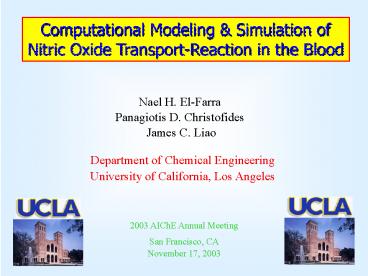Motivation PowerPoint PPT Presentation
1 / 23
Title: Motivation
1
Computational Modeling Simulation of Nitric
Oxide Transport-Reaction in the Blood
Nael H. El-Farra Panagiotis D. Christofides
James C. Liao
Department of Chemical Engineering University of
California, Los Angeles
2003 AIChE Annual Meeting San Francisco,
CA November 17, 2003
2
Introduction
- Nitric oxide (NO) active free radical
- Immune response
- Neuronal signal transduction
- Inhibition of platelet adhesion aggregation
- Regulation of vascular tone and permeability
- Versatility as a biological signaling molecule
- Molecule of the year (Science, 1993)
- Nobel Prize (Dr. Ignarro, UCLA, 1998)
- Need for fundamental understanding of NO
regulation - Distributed modeling
3
NO Transport-Reactions in Blood
- Complex mechanism
- Release in blood vessel wall
- Diffusion into surrounding tissue
- Blood pressure regulation
- Diffusion into vessel interior
- Scavenging by hemoglobin
- Trace amounts can abolish NO
- Paradox how can NO maintain its biological
function ? - Barriers for NO uptake
4
Barriers for NO Uptake in the Blood
5
Previous Work on Modeling NO Transport
- Homogenous models
- Blood treated as a continuum
- e.g., Lancaster, 1994 Vaughn et al., 1998
- Single-cell models
- Neglects inter-cellular diffusion
- e.g., Vaughn et al., 2000 Liu et al., 2002
- Survey of previous modeling works (Buerk, 2001)
- Limitations
- Population of red blood cells (RBC) unaccounted
for - Cannot quantify relative significance of barriers
6
Present Work
(El-Farra, Christofides, Liao, Annals Biomed.
Eng., 2003)
- Objectives
- Develop a detailed multi-particle model to
describe NO transport-reactions in the blood - Use the developed model to investigate sources
for NO transport resistance - Boundary layer diffusion (RBC population)
- RBC membrane permeability
- Cell-free zone
- Quantify barriers for NO uptake
7
Geometry of Blood Vessel
Physical Dimensions R50 mm, e 2.5 mm
8
Modeling Assumptions
- Steady-state behavior
- Small characteristic time for diffusion/reaction
- (10 ms)
- NO diffusivity independent of concentration or
position - NO is dilute
- Isotropic diffusion
- Convective transport of NO negligible
- Axial gradient small vs. length of region
emitting NO - Hb is main source of NO consumption
- Negligible reaction rates with O2
9
Mathematical Modeling of NO Transport
- Governing Equations
- Surrounding tissue (Abluminal region)
- Vessel wall (Endothelium)
- Vessel interior (lumen)
10
Mathematical Modeling of NO Transport
- Boundary Conditions
- Radial direction
- Azimuthal direction
- Model parameters from experiments
11
Overview of Simulation Results
- Continuum model (Basic scenario)
- Spatially uniform NO-Hb reaction rate in vessel
- Particulate model
- Barriers for NO uptake
- Red blood cells (infinitely permeable)
- RBC membrane permeability
- Cell-free zone
- Transport resistance analysis
- Numerical solutions thru finite-element
algorithms - Adaptive mesh (finer mesh near boundaries)
Model Complexity grows
12
Simulations of Continuum Model
- NO distribution in blood vessel and surrounding
tissue
13
Simulations of Continuum Model
Radial variations of mean NO concentration
14
Effect of Red Blood Cells
- Hemoglobin packaged inside permeable RBCs
- Inter-cell diffusion (boundary layer)
15
Simulations of Basic Particulate Model
- NO distribution in blood vessel and surrounding
tissue
- Blood hematocrit determines number of cells
- 45-50 under normal physiological conditions
16
Simulations of Basic Particulate Model
Radial variations of mean NO concentration for
homogeneous particulate models
17
Effect of RBC Membrane Permeability
18
Simulations of Particulate ModelMembrane
Radial variations of NO concentration for
homogeneous, particulate particulateRBC
membrane models
19
Simulations of Full Particulate Model
NO concentration profiles for homogeneous,
particulate, particulatemembrane, full
particulate models
20
Quantifying NO Transport Barriers
- Computation of mass transfer resistance
21
Relative Significance of Transport Barriers
- Fractional resistance is a strong function of
blood hematocrit - Membrane resistance dominant at high Hct.
- Extra-cellular diffusion dominant at low Hct.
22
Conclusions
- Mathematical modeling of NO diffusion-reaction in
blood - Diffusional limitations of NO transport
- Population of red blood cells
- RBC membrane permeability
- Cell free zone
- Relative significance of resistances depends on
Hct. - Practical implications
- Encapsulation of Hb in design of blood
substitutes
Acknowledgements
- NSF and NIH
23
Effect of Blood Flow
- Creates a cell-depleted zone near vessel wall
(2.5 mm)
EC
EC
EC
EC
RBC
RBC
Stationary
Flow

